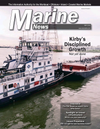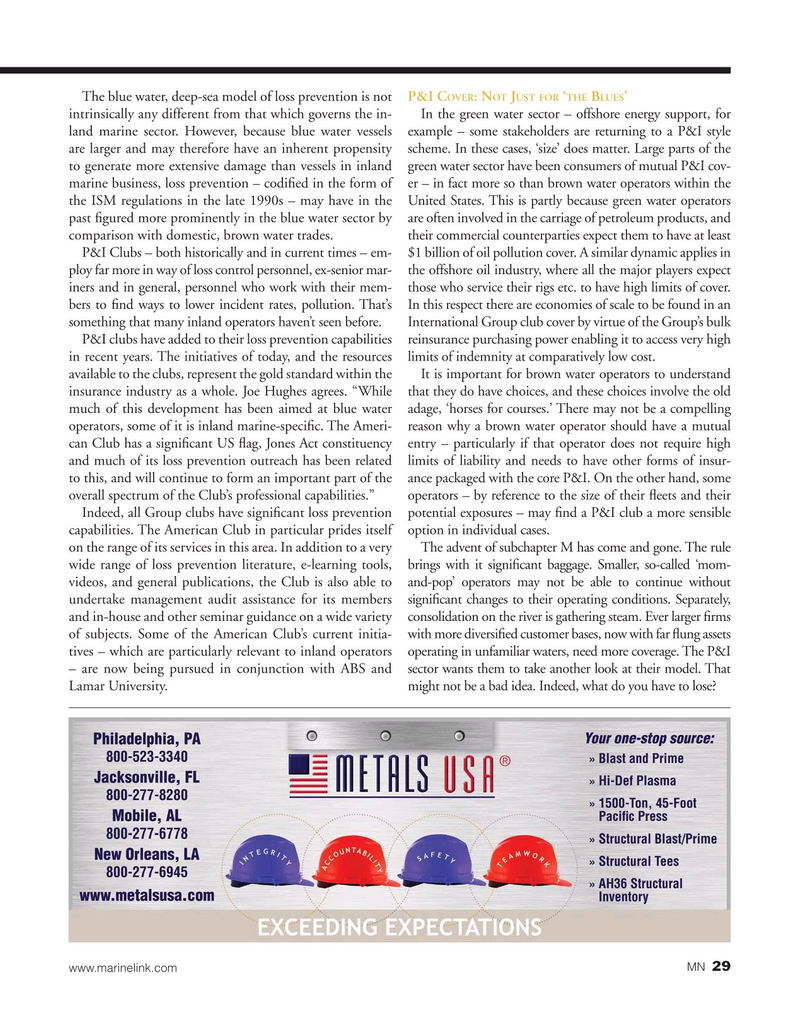
Page 29: of Marine News Magazine (May 2019)
Inland Waterways
Read this page in Pdf, Flash or Html5 edition of May 2019 Marine News Magazine
The blue water, deep-sea model of loss prevention is not P&I C : N J ‘ B ’OVER OT UST FOR THE LUES intrinsically any different from that which governs the in- In the green water sector – offshore energy support, for land marine sector. However, because blue water vessels example – some stakeholders are returning to a P&I style are larger and may therefore have an inherent propensity scheme. In these cases, ‘size’ does matter. Large parts of the to generate more extensive damage than vessels in inland green water sector have been consumers of mutual P&I cov- marine business, loss prevention – codi? ed in the form of er – in fact more so than brown water operators within the the ISM regulations in the late 1990s – may have in the United States. This is partly because green water operators past ? gured more prominently in the blue water sector by are often involved in the carriage of petroleum products, and comparison with domestic, brown water trades. their commercial counterparties expect them to have at least
P&I Clubs – both historically and in current times – em- $1 billion of oil pollution cover. A similar dynamic applies in ploy far more in way of loss control personnel, ex-senior mar- the offshore oil industry, where all the major players expect iners and in general, personnel who work with their mem- those who service their rigs etc. to have high limits of cover. bers to ? nd ways to lower incident rates, pollution. That’s In this respect there are economies of scale to be found in an something that many inland operators haven’t seen before. International Group club cover by virtue of the Group’s bulk
P&I clubs have added to their loss prevention capabilities reinsurance purchasing power enabling it to access very high in recent years. The initiatives of today, and the resources limits of indemnity at comparatively low cost.
available to the clubs, represent the gold standard within the It is important for brown water operators to understand insurance industry as a whole. Joe Hughes agrees. “While that they do have choices, and these choices involve the old much of this development has been aimed at blue water adage, ‘horses for courses.’ There may not be a compelling operators, some of it is inland marine-speci? c. The Ameri- reason why a brown water operator should have a mutual can Club has a signi? cant US ? ag, Jones Act constituency entry – particularly if that operator does not require high and much of its loss prevention outreach has been related limits of liability and needs to have other forms of insur- to this, and will continue to form an important part of the ance packaged with the core P&I. On the other hand, some overall spectrum of the Club’s professional capabilities.” operators – by reference to the size of their ? eets and their
Indeed, all Group clubs have signi? cant loss prevention potential exposures – may ? nd a P&I club a more sensible capabilities. The American Club in particular prides itself option in individual cases.
on the range of its services in this area. In addition to a very The advent of subchapter M has come and gone. The rule wide range of loss prevention literature, e-learning tools, brings with it signi? cant baggage. Smaller, so-called ‘mom- videos, and general publications, the Club is also able to and-pop’ operators may not be able to continue without undertake management audit assistance for its members signi? cant changes to their operating conditions. Separately, and in-house and other seminar guidance on a wide variety consolidation on the river is gathering steam. Ever larger ? rms of subjects. Some of the American Club’s current initia- with more diversi? ed customer bases, now with far ? ung assets tives – which are particularly relevant to inland operators operating in unfamiliar waters, need more coverage. The P&I – are now being pursued in conjunction with ABS and sector wants them to take another look at their model. That
Lamar University. might not be a bad idea. Indeed, what do you have to lose?
29 www.marinelink.com MN

 28
28

 30
30
